Credit Flows to Business During the Great Recession
During the last recession, credit flows suffered their worst slowdown since World War II. A look at selected credit market measures gives some insight into why the slowdown was so severe. The measures also show that in spite of the size of the shock, credit flows actually recovered extremely quickly—a testament to the depth of the credit markets, and possibly the interventions that were taken to support them.
Credit flows are the lifeblood of a well-functioning economy. By channeling funds from savers to borrowers, financial institutions enable businesses (and individuals) to pursue projects and activities. Disruptions to this process are costly, a lesson we learned in the last recession, as the problems that arguably started in the financial sector quickly spread to the whole economy.
The downturn in credit flows to nonfinancial businesses during the last recession was the most severe in the post–World War II period. What factors led to such a large reduction in credit flows? Although a precise answer to this question is beyond the scope of this Commentary (in fact, the economics profession cannot agree on one), there are some data that can give us clues.
One thing the data make clear is that there were multiple causes of the credit drop-off. While the financial system as a whole extended less credit, institutional differences played important roles in how and why the reductions took place. Some financial institutions had financing problems that caused them to reduce their lending; others appeared well funded but chose to decrease their lending to the nonfinancial business sector, opting for less risky investments. We argue, for example, that the high cost of obtaining credit during the recession—higher than ever before in the post-WWII period—not only affirms that firms became worse risks, but also shows that some lenders faced greater credit constraints and others grew more risk averse and hungry for liquidity.
One thing worth noting is that while credit markets suffered unprecedented levels of stress, the recovery, judging by the indicators we will look at here, was extremely quick. The rapid bounce-back is a testament to the depth of the credit markets surely, but it is also something to take into account when trying to assess whether, on balance, the credit market interventions that were put in place were positive or not.
How Bad Was It?
The Flow of Funds Accounts compiled by the Board of Governors of the Federal Reserve System contain a slew of information on U.S. financial flows, including how much nonfinancial businesses borrow each quarter (excluding farming businesses). When these data are plotted over time (figure 1), it is clear that no other post-WWII recession comes remotely close to the most recent one in terms of the magnitude of the reduction in borrowing flows. While in previous recessions borrowing flows fell by at most 2 percent of GDP, this time they fell 5 percent.1
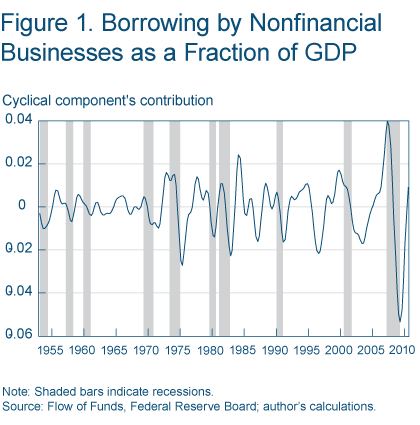
Source: Federal Reserve Bank of Cleveland
Typical recessions involve declines in both the supply of credit as well as the demand for it. It can be hard, though, if not impossible, to isolate declines in supply and demand in the data. Financial institutions wish to supply less credit because they face liquidity or solvency difficulties of their own, because the economic environment becomes more risky in general, or because they perceive their potential borrowers’ future prospects to be worse. This last reason also means the demand for loans itself may decrease. Nonetheless, the Senior Loan Officer Opinion Survey on Banking Practices provides us with some information on both supply and demand conditions in credit markets.
One thing the survey captures is how much tighter credit standards have become on commercial and industrial lines of credit (excluding mergers and acquisitions). Tighter credit standards are a proxy for reductions in the supply of credit. Data from the survey suggest that credit standards became considerably tighter in this recession than in the previous one, for businesses of all sizes (figure 2). Of course, the data from the survey are qualitative and should be interpreted with some degree of care. In addition, the data cover only bank lending, a small fraction of total flows.
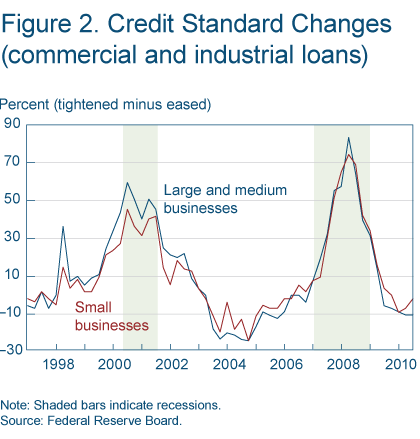
Note: Shaded bars indicate recessions.
Sources: Flow of Funds, Federal Reserve Board; author's calculations.
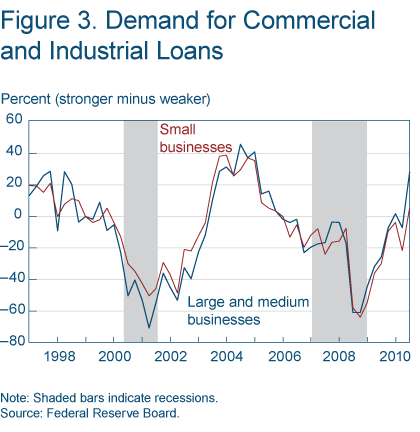
Note: Shaded bars indicate recessions.
Source: Federal Reserve Board.
The survey also asks if demand for the same type of loans has been stronger or weaker than normal, and on that issue, the latest recession does not look any worse than the previous one (figure 3).
Figures 2 and 3 together suggest that, at least as far as commercial and industrial loans are concerned, both supply and demand contracted, but given the qualitative nature of the survey data, it is impossible to measure their relative contribution.
Why Was It So Severe?
It is clear that credit flows fell more during the Great Recession than at any other time in recent history. Figuring out why is not so easy, as a number of interrelated events could be responsible. The funds available for lending were scarcer; financial institutions presumably became more risk averse as their balance sheets worsened and their attitudes towards risk changed; and feedback mechanisms were at work—as economic conditions worsened, the businesses that financial institutions would lend to became less creditworthy since their own balance sheets and future prospects had deteriorated. Moreover, for this same reason, their demand for funds also retracted.
To start the investigation, let us look at borrowing and lending flows in credit market instruments for the financial sector as a whole. Financial institutions are, compared to the average nonfinancial business, highly leveraged, meaning they borrow a lot relative to their own capital in order to conduct their operations, which involve, for the most part, lending. It is no surprise then that borrowing and lending by financial institutions are highly correlated. Figure 4 shows a measure of these flows as a fraction of GDP.2
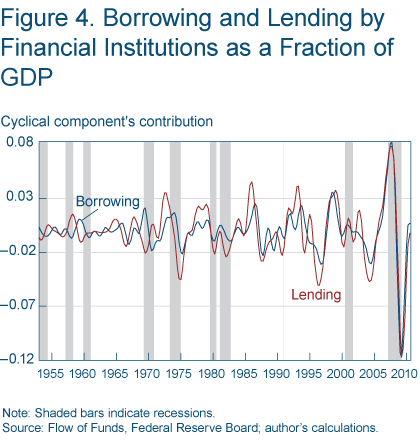
Note: Shaded bars indicate recessions.
Sources: Flow of Funds, Federal Reserve Board; author's calculations.
The figure shows that reductions in their own financing were statistically associated with less lending by financial institutions. The correlation between borrowing and lending flows is 0.82 for the whole sample, but jumps to 0.96 from 2004 on, when flows become virtually synchronous. The correlation stops short of demonstrating causation of course, but it is suggestive that, at least for the sector as a whole, financial institutions could not have lent more even if they wanted to.
By lumping all types of financial institutions together in figure 4, however, we are ignoring a substantial amount of institutional variety. For one thing, the financial system is now very different from what it was 30 or 40 years ago: banks in general play a much smaller role than they used to, as the role of the shadow banking system has grown. Second, not all of the lending in the figure is to businesses; a substantial amount is mortgage lending. Finally, depository institutions rely less on credit market instruments for funding and more on deposits, and in addition they have access to central bank liquidity, Federal Home Loan Bank advances, and the federal funds market.
The reduced credit supply during the recession was associated not only with financing issues, but also with important shifts in portfolio allocations. Consider the share of financial assets that commercial banks allocated to “safe” investments—here defined to be the sum of vault cash, reserves at the Federal Reserve, checkable deposits and currency, and Treasury and municipal securities. While it averaged roughly 3 percent in 2006, it jumped to 10 percent in 2010. Some of this jump reflects no doubt a flight to safety in light of the higher perceived risk of other investments (in particular, lending to businesses whose prospects had worsened), but also, for some institutions, liquidity and solvency concerns.
While borrowing and lending volume exchanged in the credit market carries important information, so does the price of credit. Businesses usually have a choice between financing themselves internally on the one hand, perhaps by liquidating assets or retaining earnings, or, on the other hand, obtaining funds from an external source. The higher the opportunity cost of their internal funds, the more likely firms are to choose external financing. It is usually costlier to raise funds externally: the lender knows less about the firm’s business prospects than the firm, and it must incur costs to evaluate the likelihood of default and to monitor the firm after the loan is made.
The difference between the cost of raising funds externally and internally is called the external finance premium, and it can give us important insights into the state of credit markets and how they affect the whole economy. Theory predicts that a company’s external finance premium should be inversely related to its financial situation (net worth, future cash flows, liquidity, etc). That means that the average external finance premium in the overall economy is countercyclical, as it tends to increase when GDP decreases and decrease when GDP rises.
One measure of the external finance premium is the spread between corporate bond yields and U.S. Treasury bonds of the same maturity. Just like consumers, companies can get bank loans or draw on existing credit lines, but they also have the option of issuing bonds, IOUs that promise the bearer a certain interest rate after a defined period of time. While the rates charged on bank loans are normally private information, the yields on bonds that are traded on secondary markets are public information and convey information not only about the borrower but about the state of the credit market as a whole.
Different companies will, in general, obtain different rates from the market when they auction off their bonds. Potential creditors look at a company’s financial strength and form expectations about the probability that they will actually get repaid. They then demand a return that reflects that estimation. The smaller the expected probability of a default, all other things being equal, the lower the interest rate they will require. The spreads between the interest rates associated with different types of bonds contain information about default risk, but they also reflect information about how the market values that risk.
There is always a positive spread between corporate bonds and U.S. Treasury bonds of the same maturity. One reason for that is that the market assumes there is some chance that the average corporation will default, but little to no chance that the U.S government will. Another reason is the risk premium. The risk premium is the price that the market places on the default risk. Consider two companies whose expected default rates are the same, but the structure of their businesses is such that one is more likely to default when the economy is doing well, while the other is more likely to do it when the economy is in trouble. Everything else being the same then, a default by the latter company is more costly to creditors, as it is more likely to occur at a time when their own balance sheets are probably also suffering. As a consequence, they will demand a higher return on their loan. This extra compensation is the risk premium.
Spreads between corporate bonds and government bonds of similar maturities are not a perfect measure of the external finance premium, however. They reflect different tax treatments the two types of assets are subject to, for example, and the different liquidity characteristics of the bonds, that is, how costly it is to convert the bonds into cash by selling them in the secondary market. Generally, it is more costly to convert corporate bonds than treasuries, so creditors will demand a liquidity premium in the form of higher interest rates for corporate bonds.
Figure 5 shows the cyclical component’s contribution to the spread between Moody’s seasoned BAA corporate bond index and 20-year Treasury bonds. By focusing on frequencies between 6 and 32 quarters, most of the shorter-term effects like liquidity disruptions which give rise to liquidity premia drop out, as do longer-term effects like differences in tax treatment.
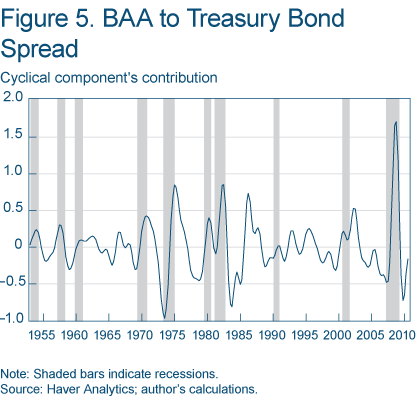
Note: Shaded bars indicate recessions.
Sources: Haver Analytics; author's calculations.
This spread is countercyclical and was at a post-WWII high during the last downturn. One might argue this is not surprising given this was the largest post-WWII recession, but even accounting for that, the spike in the spread stands out as the largest. GDP fell by two standard deviations relative to its trend in the latest recession, something that is not unprecedented, as it happened in both the 1974 and 1982 recessions. Although this is not something figure 5 shows, in each of these two occasions, the spread only jumped two standard deviations above its longer term trend. This time around it peaked at four standard deviations above its trend.
Even though this fact helps us gauge the magnitude of the stress credit markets faced in the latest recession, we would like a better understanding of what was behind this increase. Did the spread shoot up because of increases in the expected probability of default or in the risk premium associated with such defaults? Or was it because lenders fled to the safety and convenience of treasuries, a much more liquid instrument the demand for which tends to increase in times of crisis?
While we will not be able to get a definitive answer to this question, as it is hard to break down the spread into its theoretical components, we can learn something by breaking the spread into two further components. One is the spread between BAA-rated bonds and AAA-rated ones (these are issued by companies judged by creditors to be in a sounder financial position and therefore less likely to default), and the other is the spread between AAA-rated bonds and 20-year Treasury bonds. The idea is that by looking at the BAA-AAA spread we can abstract from shocks that are specific to the government bonds market, and therefore carry no information about the external finance premium, but nonetheless get transmitted to the BAA-Treasury spread.
Figure 6 presents measures of the cyclical component’s contributions to such spreads. The cyclical component of the BAA-AAA spread, our preferred measure of the external finance premium, registered a post-WWII maximum during the recession. Moreover, its contribution to the overall BAA-Treasury spread was two-thirds, which is high in historical terms. Even though there was also a large increase in the absolute contribution of the AAA-Treasury spread, it was neither the largest increase by historical standards, nor enough to keep its contribution from decreasing in relative terms.
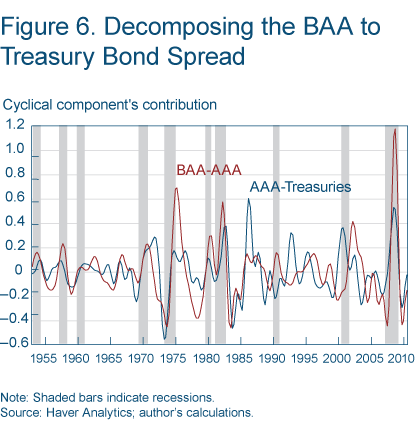
Note: Shaded bars indicate recessions.
Sources: Haver Analytics; author's calculations.
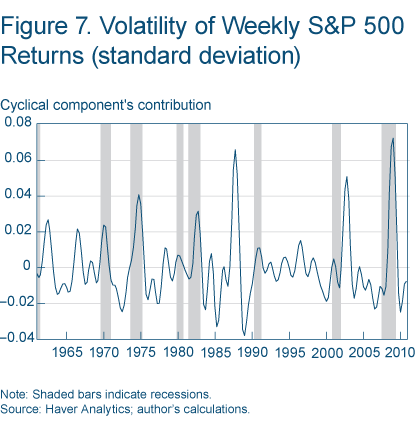
Note: Shaded bars indicate recessions.
Sources: Haver Analytics; author's calculations.
There are other possible proxies for the external finance premium. Gertler and Lown (1999), for example, advocate looking at the spread between high yield (or junk) bonds and AAA bonds, but the picture one would obtain is similar.
One can argue that the BAA-AAA spread is not entirely driven by default risk and its market price. There is also a liquidity premium between the two different bond categories. One way to proxy for default risk, as Krishnamurthy and Vissing-Jorgensen (2010) suggest, is to look at volatility in stock market returns. This volatility measure is highly correlated with measures of expected default probabilities. Figure 7 shows this measure for the S&P 500 and indicates that default risk, as measured by this proxy, was at its highest in the latest recession. Moreover, while the correlation of the volatility in stock market returns and the BAA-AAA spread is positive at 0.59 from 1961 to 2010, this value jumped to an astounding 0.98 in the 2004-2010 period, possibly indicating that during this period default risk and the BAA-AAA spread moved in lockstep.
The evidence on corporate bond spreads seems to indicate this was indeed the recession where credit market stress, as measured by the external finance premium, was at its highest. Although the analysis here does not allow one to properly control for increases in the liquidity premium, which might have contributed to the spreads as well , it seems to show that default risk and its pricing played a very prominent role in the external finance premium’s increase, even at a time when the liquidity premium was itself very high.
In sum, when looking at what might be behind the sharp decline in credit flows to nonfinancial businesses, there was a flight to liquidity, to be sure, as overall uncertainty jumped. But also, as economic conditions worsened, and nonfinancial balance sheets and expected returns took a turn for the worse, these companies became worse risks, as the market for corporate bonds shows, which contributed to further declines in credit flows.
One last thing worth noting is that while these channels suffered stress levels not seen before in the post-WWII period, the recovery, as given by the credit market indicators we have looked at, was extremely quick. This turnaround is testament to the depth of the credit markets surely, but also something to take into account when trying to assess whether, on balance, the credit market interventions that were put in place were positive or not.
Footnotes
- Note that I adjusted the borrowing flows in two ways in order to compare credit market outcomes across recessions. First I scaled the flows by the economy’s GDP, so as to make the variations in credit flows proportional to the size of the overall downturn; second, I isolated movements that occur at business cycle frequencies (6 to 32 quarters). This means I removed a growth trend that is associated with longer-term movements, as well as short-term movements that reflect day-to-day randomness. (More precisely, I filtered out movements below 6 quarters and above 32 quarters using Christiano and Fitzgerald’s (2003) band-pass filter.) This results in a component that reflects changes in fundamental economic conditions occurring around business cycles. The component can be thought of as a deviation from the longer-term trend and the short-term movements, and is the reason why the series fluctuates around a trendless mean and is a lot smoother than the actual data. Return
- We again used a band-pass filter to restrict attention to business-cycle frequencies. Return
References Cited
- “The Band-Pass Filter,” Lawrence L. Christiano, and Terry J. Fitzgerald, 2003. International Economic Review, vol. 44 (2), pp. 435-465.
- “The Information in the High-Yield Bond Spread for the Business Cycle: Evidence and Some Implications,” Mark Gertler and Cara Lown, 1999. Oxford Review of Economic Policy, vol. 15 (3), pp. 132-50.
- “The Aggregate Demand for Treasury Debt,” Arvind Krishnamurthy and Annette Vissing-Jorgensen, 2010. Unpublished manuscript.
The views authors express in Economic Commentary are theirs and not necessarily those of the Federal Reserve Bank of Cleveland or the Board of Governors of the Federal Reserve System. The series editor is Tasia Hane. This work is licensed under a Creative Commons Attribution-NonCommercial 4.0 International License. This paper and its data are subject to revision; please visit clevelandfed.org for updates.
Suggested Citation
Amaral, Pedro S. 2011. “Credit Flows to Business During the Great Recession.” Federal Reserve Bank of Cleveland, Economic Commentary 2011-15. https://doi.org/10.26509/frbc-ec-201115
This work by Federal Reserve Bank of Cleveland is licensed under Creative Commons Attribution-NonCommercial 4.0 International
- Share



